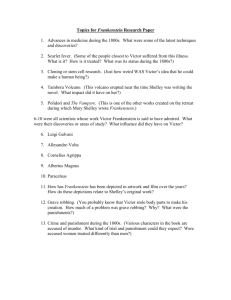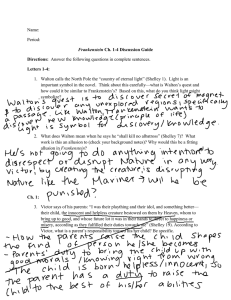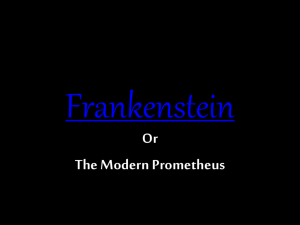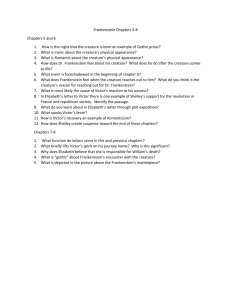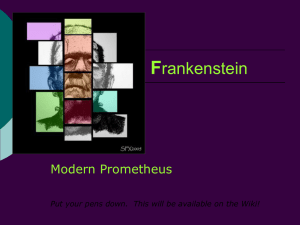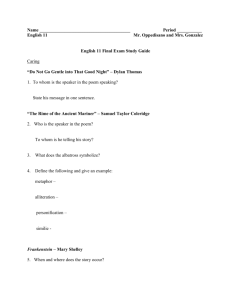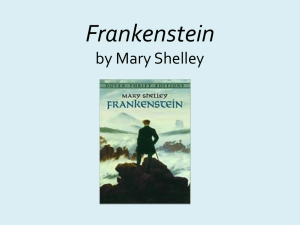Frankenstein
advertisement
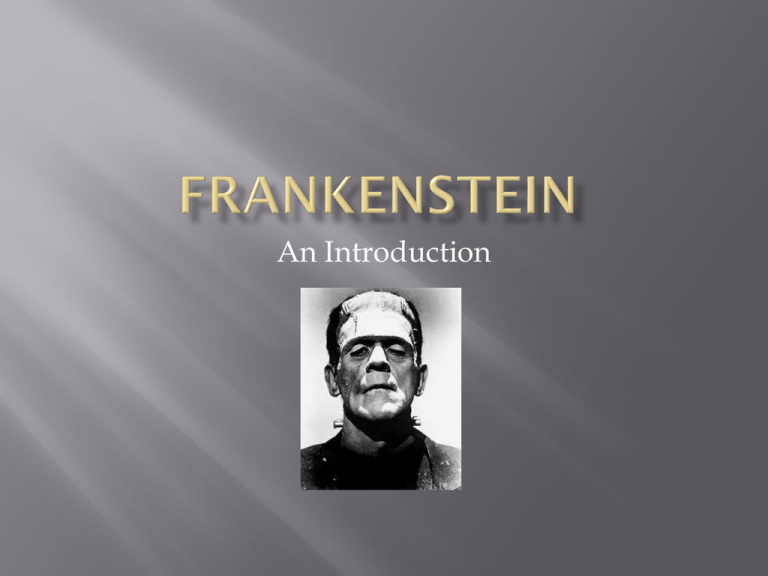
An Introduction Analyze the character development of Victor Frankenstein and the creature Identify the uses of the other various characters Identify the major elements of Romantic and Gothic literature Identify and analyze the uses of various literary devices such as foreshadowing, suspense, exposition, climax, and foils Explain and identify examples of how the Romantics railed against the Enlightenment Understand the Romantic concept of Tabula Rasa—the clean slate Understand the significance of the subtitle: “The Modern Prometheus” Debate the culpability of the two main characters, arguing both side of the issue Explain the importance of time sequence in the novel Mary Shelley was born Mary Wollstoncraft in 1797 to William Godwin and Mary Wollstoncraft—both very prominent and liberal writers. Her mother had written A Vindication on the Rights of Woman, which was a very popular feminist work. Mary spent much of her teen years writing stories in Scotland until she returned to London at age 16. She met and fell in love with Romantic poet Percy Bysshe Shelley and became pregnant. The two continued their affair until his estranged wife committed suicide, at which point they married. They lost all three of their children, and in 1822 Percy drowned in the Gulf of Spezia in Spain. At the age of 24, she was an impoverished widow, and she supported herself with her writing. Frankenstein was published in 1818 when she was only 20 years old. It is considered a huge feminist feat because it was written by a female child of a world-renowned early feminist. However, there are very few female characters, and other than Safie (the wife of one of “the cottagers”) they are not particularly strong female roles. 1789: the start of the French revolution (an attempt of the French people to rid themselves of their absolute monarchy). British liberals were excited that the common people were standing up to their oppressors, but they quickly became disillusioned when the revolution became very bloody and its leaders became tyrants themselves. 1793-1794: the French Reign of Terror under Robespierre. British liberals lost all hope for true justice and equality in that year. 1804: Napoleon is crowned emperor. During this whole time, Romantic writers were turning towards nature as an escape from the harsh realities of their world. Nature was someplace where human tyranny did not reign. The Romantics were, for the most part, disheartened liberals. They sought solitude in nature, believing that the key to all emotional healing could be found in nature. Nature imagery is the most predominant feature of Romantic literature. The idea of the disenfranchised man was also very common. Such men, who found themselves unable to live in society, were often revered and/or sympathized with. Frankenstein and his creature are both disenfranchised men—the creature because his form keeps him from any human company and Frankenstein because he eventually feels that he cannot enjoy the company of his fellow men after unleashing a monster among them. Many Romantics dealt with the supernatural. One common Romantic trait was making ordinary, everyday things seem wonderful and aweinspiring. However, some went a step further and dealt with nonnatural things. Frankenstein’s creature (and his education/life) is not a common thing. It could not possibly be a real thing. Up until the Romantic era, writers wrote fiction that read as though it could possibly be real—and was often taken for truth. Frankenstein cannot be misconstrued as real. It was an offshoot of Romantic literature. Gothic literature was the predecessor of modern horror movies in both theme and style. Gothic literature put a spin on the Romantic idea of nature worship and nature imagery. Along with nature having the power of healing, Gothic writers gave nature the power of destruction. Frankenstein is full of the harsh reality of nature. Many storms arise in the book, including storms the night the creature comes to life and the night Frankenstein destroys the corpse of the second creature in the Irish Sea. The most common feature of Gothic literature is the indication of mood through the weather. When bad things are going to happen in a Gothic novel, the reader knows it because there inevitably a storm outside. This is till true in many books and films. Modern readers are often puzzled by Victor’s approach to discovering the “elixir of life” in that he does not seem to perform scientific experiments as much as read books. Prior to the 18th century, what we call “science” and what we call “philosophy” were essentially the same disciplines. The study of nature and the desire to know how nature functions eventually came to be called “natural philosophy,” but the quest for such knowledge was still more what we could consider philosophical than scientific. Mary Shelley indicates that Victor is a student of this “natural philosophy” when she indicates who some of Victor’s early influences were. While admitting that many of these men’s theories had been discredited, Victor still admits that it was they who largely set him on the course he was eventually to take. A Renaissance philosopher and scientist whose works reflect a strong interest in the occult and ancient, mystical “sciences” of the near East Writing blends European interpretations of Plato’s philosophy with Jewish Kabalistic beliefs “De incertitude et vanitate scientarium” (the vanity and uncertainty of the arts and sciences), published in 1527, is a treatise on the occult as a hidden knowledge that existed in Renaissance Europe and was known to a select few Collection of thoughts on Renaissance magic including such diverse topics as astrology and the effect of planetary motion on human events, occult virtues, the natural tendency of certain “elements” to work harmoniously together and others to oppose one another, spells, methods of predicting the future, numerology, the divine Trinity, the Kabalistic Names of God, and the orders of evil spirits In terms of “real science,” his ideas have all but been discredited by later thinkers and by the processes of observation and experimentation Renaissance philosopher and scientist who introduced a new concept of disease and the use of chemicals rather than herbs to treat diseases Asserted that diseases were caused by external agents attacking the body, contrary to the then-traditional idea of disease as an internal upset of the balance of the body’s humors (yellow bile, black bile, blood, and phlegm); to cure the disease, one needed to attack this external agent Alchemy became the means by which chemical remedies were prepared; thus, Paracelsus changed the emphasis of the alchemy from chasing the mythological “Elixir of Life” or “Philosopher’s Stone” to making medicines Some of his ideas, however, bordered on the occult He was said to have been taught the secret of the universal solvent in Constantinople Believed to have had such tutors as gypsies and sorcerers and affected miraculous cures of several maladies Renaissance philosopher and scientist who advocated the search into the natural causes of things apart from the church’s position that God was the cause of all effects “The aim of natural science is not simply to accept the statements of others, but to investigate the causes that are at work in nature.” Radical idea for the time, as most scholars believed the scripture to be the sole source of all knowledge; Magnus advocated the scientific approach but did so in a way that his ideas were accepted by the Church “In studying nature, we have not to inquire how God the Creator may, as He freely wills, use His creatures to work miracles and thereby show forth his power: we have to rather inquire what Nature with its immanent causes can naturally bring to pass,” thus placing the emphasis on understanding how nature worked than trying to understand God Contemporary critic Roger Bacon wrote that Magnus “…is a man of infinite patience and has amassed a great amount of information, but his works have four faults. The first is boundless, puerile vanity; the second in ineffable falsity; the third is superfluity of bulk; and the fourth is his ignorance of the most useful and the most beautiful parts of philosophy.” Bacon was, however, an even stronger advocate of experimental science than Magnus but did not feel compelled to reconcile his scientific theories with Church doctrine. He was also able to demonstrate a number of factual and reasoning errors in Magnus’s work. Round character: fully developed and multidimensional Flat character: based solely on one trait or characteristic Dynamic character: develops through the course of the story Static character: does NOT develop through the course of the story Foil: character who is the opposite of another character used to shed light upon the character of the latter Catalyst: character (or event) that starts another chain of events; the first “domino” to fall ad hit the other “dominoes” SPOILER ALERT! The Frankenstein family, Elizabeth, and Justine are used as the reason for Victor’s revenge. They exist only to be killed by the monster (or society), thus giving Victor the motivation he needs to rid the world of the monster. Also, Mrs. Frankenstein’s death is what makes Victor wish to create, and ultimately to restore, life to inanimate objects. Henry Clerval is used as another reason for Victor’s revenge. He is also a foil for Victor by showing how scientific and, often, un-Romantic Victor is. Henry is Shelley’s way of showing how life could be for Victor if he were not given to passion for science. Robert Walton is Shelley’s device that allows Victor to tell his story. Just as Victor uses him to be the scribe of his story, Shelley uses him to be the reason the story is told. M. Waldman is purely a catalyst for Victor to return to natural philosophy and continue his creation. The cottagers are the means through which the creature learns how to speak (so he can tell his story) and how to “socialize.” They are the single most important factor in making the creature long for human company and then for his feeling of utter despair that drives him to murder. Frankenstein has a very complex character change throughout the story, mainly because the story covers his entire life. Because of the inverted time sequence (the bulk of the novel is a flashback and a flashback-within-a-flashback), his character in the book is not in the same sequence as in real life. Through the course of his own life, he evolves from being a happy and loving child with a love of knowledge, to a science-obsessed youth, to a broken and “wiser-for-the-wear” man. The various sorrows he endures through his life, and his decade-long sense of guilt for having created such a murderous being, wear on him until he is a prematurely aged and sickly man. Most important to mention is his change in philosophy over his development. After all the havoc he unintentionally reeks on himself, he decides that it is better to enjoy life than to go after fame, glory, and knowledge. After all that he learns, he feels that ignorance is bliss. In essence, Victor carries the moral of the story. The creature also has a very important development in the story. Chronologically, he begins life as a tabula rasa (clean slate). He is a grown being, similar to human although horribly deformed. He has no history, no family, nothing to help determine who he would be become. He only develops a personality through the observation of others and books, he has no “God-given” tendencies because he was not created by God. He only has the potential for everything. His first feelings of loneliness and rejection (first by his own creator and then by the inhabitants of the town where he finds himself) make him feel sadness. He eventually observes the goodness of the cottagers, and he becomes good. But when they—and everyone else—spurn him, his rage and sorrow become unchecked, and he begins his revenge. The people he encounters and their meanness toward him teach him meanness (he mentions that he learns about murder in history books). He literally becomes what society makes him. The creature is Shelley’s warning to the reader. The writer’s comparison of his or her characters to the characters in other well-known works of literature Allows author to garner much information in only a title or a character name; by alluding to a work with which everyone is familiar, all of the connotations of the one work are transferred to the new one Shelley uses many literary allusions, referring mostly to Milton’s Paradise Lost and the biblical account of Adam and Eve Fundamental and well-known story in Western culture Shelley wanted people to bring the back story of Paradise Lost to Frankenstein: the idea of the proud and inquisitive creature being cast out as well as the idea that being cast out was a horrible thing Another obvious literary allusion in Frankenstein is its subtitle: “The Modern Prometheus.” Prometheus was a Greek god who was in charge of giving out gifts to the various creatures on Earth. He gave out speed and instinct and such. By the time he got to mankind, he was out of gifts. He decided to go against orders and gave man fire (symbolic of knowledge). The other gods were angered by his disobedience (partly because now man was too godlike). Prometheus’s punishment was that he was chained to a rock. Every day a vulture came and devoured his liver. Every night the liver grew back to be devoured the next day. Prometheus by Gustave Moreau Prometheus Bound by Jacob Jordaens Museum Collection: Musei Vaticani, Vatican City Catalogue Number: TBA Beazley Archive Number: N/A Ware: Laconian Black Figure Shape: Amphoriskos Date: ca 530 BC Period: Archaic Prometheus by Elsie Russell

